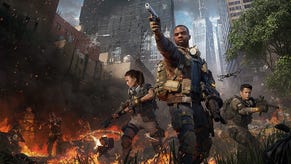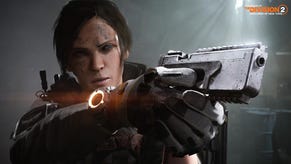Warlords of New York Turns The Division 2 Into Mega Man
Massive Entertainment's expansion improves The Division 2 with a tighter focus.
This article first appeared on USgamer, a partner publication of VG247. Some content, such as this article, has been migrated to VG247 for posterity after USgamer's closure - but it has not been edited or further vetted by the VG247 team.
As a native of the D.C. Metro area, when it was announced that The Division 2 would take place in Washington, D.C., I was excited. D.C. is a location full of history, the seat of the nation's power. It's the home of landmarks like the White House, the Lincoln Memorial, the Capitol Building, and the Smithsonian. I know these places and regions like Georgetown or Foggy Bottom, and I had a kick seeing them recontextualized through the lens of The Division's viral outbreak.
While I enjoyed seeing all that D.C. had to offer during the story campaign, the frayed edges of The Division 2's experience began at endgame. Loot was a mess. It relied entirely too much on randomness to get the items you wanted—imagine trying to pull the letter "B" at random out of every written character ever and you'll have an idea of what it was like to find a specific piece of gear to complete a build. You had to hope it was the right base gear, with the correct stats and talents to synergize with what you already had. And the item rolls were wide. Rising through the endgame World Tier required redoing content over-and-over again just to push yourself up on Gear Score range. And the endgame antagonists, Black Tusk, were simply not all that interesting narratively or in your encounters with them.
Well, Massive heard players' complaints, and now the fix is in. That fix is called Warlords of New York, a return to the city the first game called home. The Division's massive overhaul, patch 1.8, came 22 months after the game's launch, so it's surprising to see Massive turning things around in a single year.

At the start of the expansion, The Division agents roosting in Washington D.C. get a call from New York: it's time to head back to Lower Manhattan to help the locals against an insurgent force of rogue Division agents. These agents are led by the elusive Aaron Keener, the former Division member that players have been tracking since the first game. Keener is the Dr. Wily to his own group of Robot Masters; you have to hunt down and polish them off to find Keener himself. Each is holed up in their own spot of Lower Manhattan. Stealth operative Javier Kajika is hiding in Battery Park, drone commander Theo Parnell is killing folks in Civic Center, Cleaner boss Vivian Conley rules within Two Bridges, and heavy weapons expert James Dragov is wreaking havoc in the Financial District.
Getting on the chopper to New York for the first time, I was surprised at how focused Warlords of New York is. Within 5 minutes, you're dropping into New York, taking fire and fighting your way toward City Hall. Another few minutes, and you're introduced to your antagonists, and just a short time after that, The Division mainstay Faye Lau comes screaming back into the picture. Then you're sent on your mission—you can hunt the four rogue Division agents in any order—and you're out into the streets of Manhattan again. Warlords of New York isn't a wandering shuffle, it's a firm drumbeat that pushes you forward step by step.
While I like the landmark aspects of Washington D.C., Massive didn't always use the city's environments to provide interesting encounter spaces. It's clear that the developer has learned from this error, and this version of Manhattan is different. There's far more variety in terms of spacing, with very tight streets and alleys giving way to wide, flat spaces. There's more vertical locations, like one fight that takes place in a mess of catwalks and shipping cranes. You'll also find a few more divots and craters in the landscape, which allow your enemies to flank you out of sight.

Visually, there's also a greater effort to make the world itself appear more unique, since it can't rely on as many big ticket landmarks like in The Division 2's D.C. You'll jump from the trash-filled streets and ruined quarantine infrastructure of the Battery Park area, with skyscrapers looming above, to the lush green overgrowth of the Two Bridges region. There's a ton of new vistas to see in Warlords of New York, but they generally aren't of the variety of "look at this ruined building you know." Instead, they lean toward making you speculate how the outbreak caused this region of the city to twist into this new form. On my way to the Brooklyn Bridge, I found an area of the bridge wreathed in subway cars, used as a precarious outpost by rogue elements, complete with hanging bodies among the trains. It's a strong utilization of the world itself toward more imaginative ends.
This feeling of imagination also extends to the missions themselves. When I was hunting Javier Kajika, I found him deep underground with huge machines bellowing steam and flame moving around me. Facing Kajika himself required dodging his cluster shock mines and nearly-silent arrows, but also avoiding areas of damaging steam, and draining rampant flood waters to reach him. Parnell has you diving through the Rikers' eponymous prison stronghold, with almost horror-esque corridors of wire connecting everything to a hive mind, before rising to the quiet, austere halls of a nearby courthouse. And Conley has weird encounter mechanics, like a goddamn hose of flame that sweeps its way across the battlefield, forcing you to keep moving.
The Mega Man comparison with Keener's lieutenants is an apt one, as you get a unique skill for defeating each of them. Conley, for example, gives you the old Sticky Bomb. None of the abilities are too strong or game-breaking, at least not within my current build, but it feels good to get a unique reward for your hunt.
I also have to laud Massive for the absolutely wonderful change in gear. Gear 2.0 was the other major addition of Warlords of New York, though it's the one that affects players that don't own the expansion as well. Talents are gone for nearly every piece of gear, except for chest armor, backpacks, and weapons. Gear stats have been cleaned up as well, with a small set of Core Attributes. These Core Attributes are Weapon Damage, Armor, and Skill Tier, and most of the additional stats on any items reinforce the core. It's far cleaner in terms of sorting through gear and aiming toward a specific build.
Even better is the new gear recalibration system. Now, you can extract a single talens, core attribute, or attribute from a piece of gear and that goes in your Recalibration Library forever. Before, you might find a good stat and never want to reuse it on an item, because then it'd be gone. Now, you're building a library of useful ways to reconfigure your gear. It feels like you're working toward a larger goal, seeing your library beef up. You can also tell on the fly if a piece of found gear has a stat that you need in your Library, meaning you immediately know if you need to keep a piece or discard it.
Warlords of New York isn't without its problems though. While the idea of the hunt is a strong one, the narrative for each rogue Division agent doesn't have time to breathe, because the overall missions themselves are pretty short. I cleaned the entire thing in under 10 hours. I had a number of audio sync issues early on, with character dialog being way off sync. I also had one straight hardlock, where I vaulted up onto a box and was unable to move or access any menus. And ultimately, once you reach the new level cap of 40, you get a brand-new progression system, and without much more time with it, I'm not sure how that will factor in the ongoing endgame.

That endgame involves Keener, Lau, and the rest of the cast that Massive has built up to this point, and spins the entire plot into the upcoming Seasons content. So far, I can say I'll probably be more committed to this than I was The Division 2's vanilla endgame.
Where Warlords of New York wins is in its intense focus. I won't miss Washington D.C., partially because you can jump right back to it once you're done with the expansion. Lower Manhattan shows The Division 2 at its current best. Massive knew what to cut, what to beef up, and how long it could sustain what it had. And at the very least, it shows that the studio knows that just having more content isn't what matters. It's having the right content.








